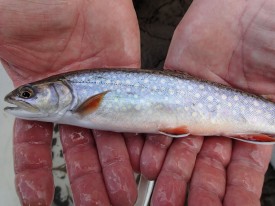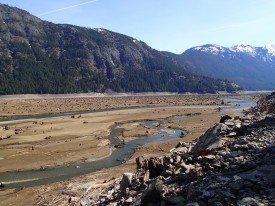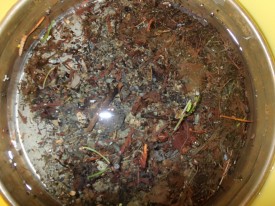by Emily Derenne, Master’s candidate, Western Washington University, and Leo Bodensteiner, Professor, Western Washington University
Ross Lake is a 23-mile long reservoir created by the installation of Ross Dam on the upper section of the Skagit River in 1949. Located at the southern end of the lake, Ross Dam is 540 feet high, and is operated by Seattle City Light to provide power to the city of Seattle. The lake is deepest near the dam and varies in depth with the season. During the winter, the lake is drawn down for storage to less than 100 feet deep. In the summer, the lake is filled to 400 feet deep for recreational access and more power generation. Ross Lake is oligotrophic and monomictic, only mixing once during the year. Very little aquatic vegetation is found along the lake’s shoreline, dissolved oxygen is near saturation from surface to bottom, and the lake is thermally stratified during the summer. Access to the lake is provided by a 1.6-kilometer hiking trail from Highway 20 to the dam and a 50 kilometer logging road from Hope, British Columbia, to the northern end of the lake.
Ross Lake fish populations
Ross Lake is home to a variety of fishes, all of which rely on aquatic insects for food as juveniles. Native fishes are limited to Rainbow Trout (Oncorhynchus mykiss), Bull Trout (Salvelinus confluentus), and Dolly Varden (Salvelinus malma). All three are adfluvial in Ross Lake, living in the lake and migrating to rivers or streams to spawn. In 1999, Bull Trout in the Puget Sound and Washington coastal areas were listed as threatened in the lower 48 states under the Federal Endangered Species Act (USFWS, 2012).
The lake hosts the only known co-existing lake-based populations of Bull Trout and Dolly Varden in North America (E. Connor, Seattle City Light, personal communication), and the Ross Lake Bull Trout population is geographically isolated and genetically unique. Dolly Varden and Bull Trout, both members of the char genus, are difficult to tell apart. Hybrids have also been documented between these two species, so genetic analysis is required for positive identification (Quinn, 2005). Recently, the size distribution has been shifting to larger Bull Trout, and the population appears to be increasing (Welch, 2012).
The population of Rainbow Trout in the lake is believed to be declining, affected by competition from the recently introduced Redside Shiner (Richardsonius balteatus) population as juveniles, and, as adults, by Bull Trout who compete with them for shiners as a food source (Welch, 2012). Native char may not be harvested because of their ESA status, but Rainbow Trout are an important recreational species in the lake.
Cutthroat Trout (Oncorhynchus clarkii), Eastern Brook Trout (Salvelinus fontinalis) and Redside Shiner are the fishes introduced to the lake. Cutthroat Trout and Brook Trout were stocked historically, while Redside Shiners were probably introduced as bait fish around 2000. Cutthroat Trout and shiners are native to Washington, but not to Ross Lake (Welch, 2012).
Eastern Brook Trout, thought to have been introduced to Washington around 1894 and on the rise within the lake, adversely affect Bull Trout populations (MacCrimmon and Campbell, 1969; NPS, 2009). Brook Trout reproduce earlier in their life cycle than Bull Trout, often leading to the replacement of Bull Trout populations (USFWS, 1998, Gunkel et al, 2002).
The role of perennial streams in fish diets
My graduate work, in cooperation with the North Cascade National Park aquatic resources group, has focused on the habitat use and diet of juvenile fishes in former tributaries to the upper Skagit River that are now submerged for half the year. The study’s intent is to identify the importance of these stream segments to fish by assessing the presence and availability of prey and habitat as pool height changes.
In 2013, I selected three perennial streams to study when Ross Lake was at its lowest level, beginning during the last week of March. On monthly visits, I collected GPS data to map the stream courses and my sites below the full pool level of the reservoir, classified and quantified stream habitats, measured water quality parameters, and sampled benthic macroinvertebrates. I collected, identified, and measured fish in the streams at sites on the reservoir bottom and at locations above the full pool level. In the field I removed stomach contents (without killing the fish) to compare to my invertebrate sample collections. I am currently analyzing all this information in the lab.
While my analysis is not complete, I have learned that these submerged stream segments do provide habitat used by juvenile char and trout. A variety of aquatic insects are present, including mayflies, stoneflies, caddisflies, midges, worms, leeches, amphipods, and others. Mayflies and midges were the macroinvertebrates found most frequently across all sites. Results also suggest they were the most common diet item across all sites and all fish species.
I look forward to completing my analysis and sharing final results about fish usage of these habitats.














